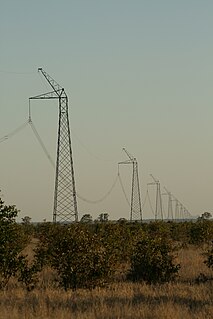Related Research Articles

A high-voltage, direct current (HVDC) electric power transmission system uses direct current (DC) for electric power transmission, in contrast with the more common alternating current (AC) systems.

The Pacific DC Intertie is an electric power transmission line that transmits electricity from the Pacific Northwest to the Los Angeles area using high voltage direct current (HVDC). The line capacity is 3,100 megawatts, which is enough to serve two to three million Los Angeles households and represents almost half of the Los Angeles Department of Water and Power (LADWP) electrical system's peak capacity.

The Nelson River DC Transmission System, also known as the Manitoba Bipole, is an electric power transmission system of three high voltage, direct current lines in Manitoba, Canada, operated by Manitoba Hydro as part of the Nelson River Hydroelectric Project. It is now recorded on the list of IEEE Milestones in electrical engineering. Several records have been broken by successive phases of the project, including the largest mercury-arc valves, the highest DC transmission voltage and the first use of water-cooled thyristor valves in HVDC.

Cahora-Bassa is an HVDC power transmission system between the Cahora Bassa Hydroelectric Generation Station at the Cahora Bassa Dam in Mozambique, and Johannesburg, South Africa.
Virginia Smith Converter Station is a high-voltage direct current (HVDC) back-to-back converter station near Sidney, Nebraska. Completed in 1988, it is significant for being the first interchange between eastern and western United States electrical grids. The station can transfer a maximum power of 200 megawatts and the voltage used is 55.5 kV.

The Texas Interconnection is an alternating current (AC) power grid – a wide area synchronous grid – that covers most of the state of Texas. The grid is managed by the Electric Reliability Council of Texas (ERCOT).

A black start is the process of restoring an electric power station or a part of an electric grid to operation without relying on the external electric power transmission network to recover from a total or partial shutdown.

J. Robert Welsh Power Plant is a 1-gigawatt, coal power plant located east of Pittsburg, Texas in Titus County, Texas. It is operated by SWEPCO, a subsidiary of AEP. The plant is named after J. Robert Welsh, a former President and Board Chairman of SWEPCO.
Châteauguay HVDC-back-to-back station is the largest high-voltage direct current (HVDC) back-to-back converter station in North America. Situated near Châteauguay, on the South Shore of Montreal, Quebec, it is an important plant for power exchange between Hydro-Québec and New York Power Authority (NYPA).
The watt is the unit of power or radiant flux in the International System of Units (SI), equal to 1 joule per second or 1 kg⋅m2⋅s−3. It is used to quantify the rate of energy transfer. The watt is named after James Watt (1736–1819), an 18th-century Scottish inventor, mechanical engineer, and chemist who improved the Newcomen engine with his own steam engine in 1776. Watt's invention was fundamental for the Industrial Revolution.

McNeill HVDC Back-to-back station is an HVDC back-to-back station at 50°35'56"N 110°1'25"W, which interconnects the power grids of the Canadian provinces Alberta and Saskatchewan and went in service in 1989. McNeill HVDC back-to-back station is the most northerly of a series of HVDC interconnectors between the unsynchronised eastern and western AC systems of the United States and Canada. The station, which was built by GEC-Alstom, can transfer a maximum power of 150 MW at a DC voltage of 42 kV. The station is unusual in many respects and contained several firsts for HVDC.
The Yunnan–Guangdong HVDC is a high-voltage direct current transmission system connecting Chuxiong in the Yunnan to Suidong, Zengcheng in Guangdong, China. It is the first HVDC link in the world operating at a transmission voltage of 800 kV. The transmission line is operated by China Southern Power Grid. In 2007, the order to supply the system was awarded to Siemens Energy. The first pole was put into operation in December 2009 with the second pole to follow in June 2010.
The Trans Bay Cable is a high-voltage direct current (HVDC) underwater transmission cable interconnection between San Francisco, California and Pittsburg, California. The 53 mi (85 km) cable under San Francisco Bay and through the Carquinez Strait can transmit 400 megawatts of power at a DC voltage of ±200 kV, enough to provide 40% of San Francisco's peak power needs.
The Black Sea Transmission Network is a project for electric power transmission from Georgia to Turkey.

HVDC HelWin1 is a high voltage direct current (HVDC) link built to transmit Offshore wind power to the power grid of the German mainland. The project differs from most HVDC systems in that one of the two converter stations is built on a platform in the sea. Voltage-Sourced Converters are used and the total cable length is 130 km. The project was completed and handed over to its owner, TenneT, in February 2015.
The Hudson Project is a 345 kV AC powerline for the power supply of New York City from PSEG's Bergen Generating Station, in Ridgefield, New Jersey. It was laid by Anbaric Development Partners.

The Talcher–Kolar HVDC system, otherwise known as the East–South interconnection II is a 1450 km HVDC transmission connection between the eastern and southern regions in India connecting four states namely Odisha, Andhra Pradesh, Tamil Nadu and Karnataka. The system has a transmission voltage of ±500 kV and was originally put into service in March 2003, with a rated power of 2000 MW. In 2007 the scheme was upgraded to 2500 MW.
The Xiangjiaba–Shanghai HVDC system is a ±800 kV, 6400 MW high-voltage direct current transmission system in China. The system was built to export hydro power from Xiangjiaba Dam in Sichuan province, to the major city of Shanghai. Built and owned by State Grid Corporation of China (SGCC), the system became the world’s largest-capacity HVDC system when it was completed in July 2010, although it has already been overtaken by the 7200 MW Jinping–Sunan HVDC scheme which was put into operation in December 2012. It also narrowly missed becoming the world’s first 800 kV HVDC line, with the first pole of the Yunnan–Guangdong project having been put into service 6 months earlier. It was also the world’s longest HVDC line when completed, although that record is also expected to be overtaken early in 2013 with the completion of the first bipole of the Rio Madeira project in Brazil.

The electrical power grid that powers Northern America is not a single grid, but is instead divided into multiple wide area synchronous grids. The Eastern Interconnection and the Western Interconnection are the largest. Three other regions include the Texas Interconnection, the Quebec Interconnection, and the Alaska Interconnection. Each region delivers power at a nominal 60 Hz frequency. The regions are not usually directly connected or synchronized to each other, but there exist some HVDC Interconnectors. The Eastern and Western grids are connected with 1.32 GW.
References
- ↑ "Welsh, USA Siemens Energy HVDC references". Archived from the original on 2017-10-10. Retrieved Oct 9, 2017.
Coordinates: 33°03′30″N94°50′39″W / 33.0583°N 94.8441°W